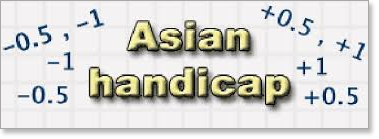Hang Cheng betting is known to Europeans as Asian Handicap betting.
There are some very good reasons why Asian Handicap betting is so popular in Asia. Compared to traditional fixed odds betting Asian Handicap betting is slightly more complicated, but wins hands down when it comes to betting on soccer. Here’s why;
- There is no ‘draw’ with Asian Handicap betting, there are only two outcomes to bet on, the home win or away win.
- The return from money staked is more frequent and it is possible to win the bet if the team draws or loses a match.
The handicap
The Asian Handicap is the same as any handicap and is applied to level the chances of either team winning. The teams are split into the underdog and the favourite.
The underdog is shown by a plus sign, because they get more goals. England who would be the underdogs against Brazil may be priced like this; England +1. The underdog’s extra goals are added to their goal total at the end.
The favourite needs to be brought down a level and has goals deducted which may look like this; Brazil -1. The goals are ‘handicapped’ or deducted from their final goal total.
To start with and to make things more simple the handicaps include a no ball, half ball, and one ball handicap. These handicaps correspond to the odds for the game.
Examples
England +0.5 vs. Brazil -0.5. England’s final score is increased by half a goal and Brazil’s score is reduced by half a goal. Simply, the only result is win or lose. Brazil has to win by at least 1 goal for the bet to win. Whereas any other result produces a win for the underdog.
England 0 vs. Brazil 0. If the teams are evenly matched they will have a 0 handicap. It is possible to bet on either team to win the match. If the match ends in a draw all bets are refunded.
England +1 vs. Brazil -1. Using our example again, a bet on England will win as long as Brazil doesn’t win by 2 goals or more. If Brazil wins by 2 goals or more, the bet would be lost. If the underdog loses by 1 goal or the favourite wins by only 1 goal then the bet is refunded.
A normal bookmaker would offer a range of odds on a soccer game that couldn’t possibly be represented by a 0.5, 0 and 1 goal handicap. Asian Handicap bookmakers compensate for this by offering a split handicap.
Split (double or quarter) handicap:
The split handicap gives various scenarios producing either a win, partial win or refund which is why Asian Handicap betting produces less in the way of losing bets.
The best way to understand the split handicap is to imagine your stake is automatically divided equally and placed as two separate bets. Lets look at the possible outcomes;
- Full Win: Both bets win
- Half Win: One bet wins and the other bet push (stake returned)
- Half Lose: One bet push (stake returned) and the other bet loses
- Full Loss: Both bets lose
Asian Handicap line 0.75 (also marked as 3/4 handicap or 0.5 & 1) ball handicap:
With a handicap of 0.75, half your stake will be at a 0.5 ball handicap, and half at a 1 ball handicap.
England +0,75 vs. Brazil -0,75:
A stake of €100 on Brazil (-0.75) means:
- €50 of your stake will go on Brazil ‘minus half a goal’
- the other €50 will go on Brazil ‘minus one goal’.
To work out your return, simply calculate the return from each of the two separate€50 bets. Each bet is calculated in the same manner as a single ball handicap. Thus, if Brazil win the match by one goal, the €50 stake at ‘minus half a goal’ is determined to be a winning bet, and the other half of the wager (€50 at ‘minus one goal’) is determined to be a refund.
You will win on your full €100 stake (both €50 bets) if Brazil win by 2 or more goals.
 Vetem Baste Welcome to betting world
Vetem Baste Welcome to betting world

